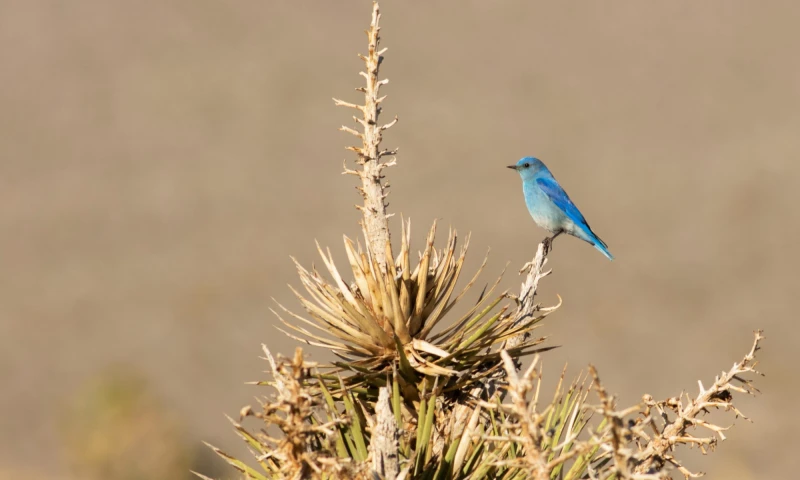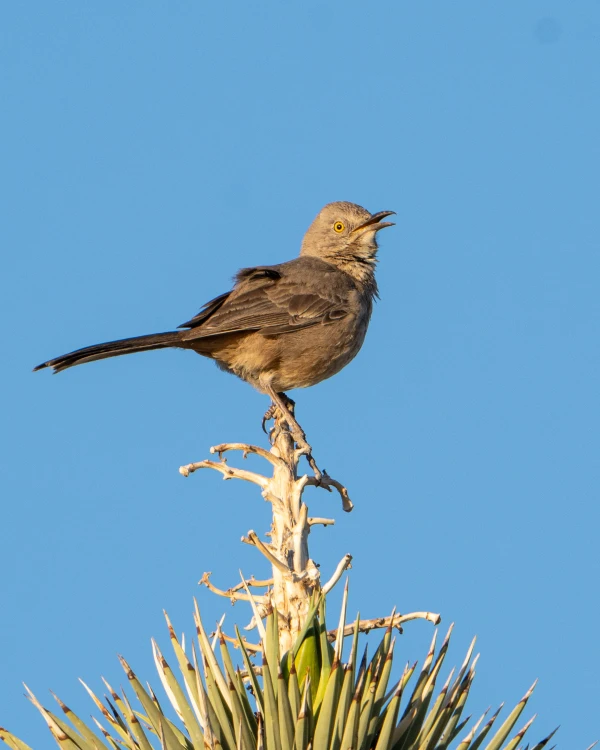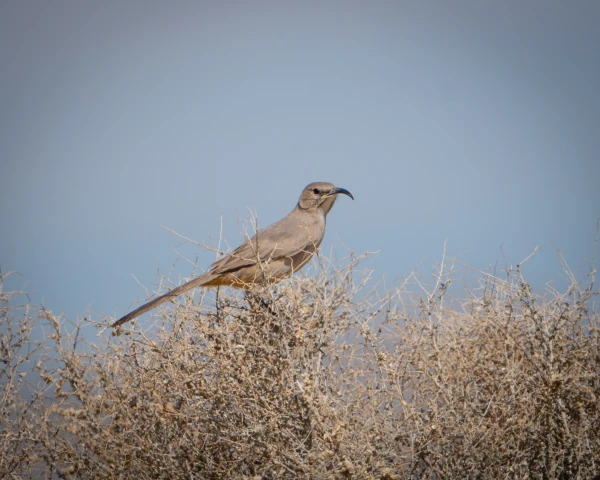By Alex Harper
Avi Kwa Ame National Monument and surrounding deserts support a variety of birds, insects, plants, and
vertebrates. The monument lies just east of the center of the Mojave Desert. The Mojave Desert is a
landscape that is placed north of the warmer and wetter Sonoran Desert, west of the higher elevations
of the Colorado Plateau, south of the colder Great Basin Desert, and east of the Sierra Nevada. Habitats
in the Mojave Desert are often characterized by dominant plant species, and these plants are most
influenced by elevation. It’s helpful to think of these as plant communities, and many birds prefer
certain plant communities. By recognizing plant communities, you’ll draw more conclusions about how
birds live across this dynamic landscape.
Basins and lowlands are dominated by communities of shrubs creosote and bursage. The upper reaches
of the monument have pinyon pine and Utah juniper woodlands. Joshua trees are found generally in
between these plant communities. Like any landscape, Avi Kwa Ame and the rest of the Mojave Desert
are dynamic. Seasons greatly affect the behaviors and patterns of birds as they move across, in, and out
of Avi Kwa Ame over time.
Depending on the timing of your visit, birds may be obvious, or they may seem few and far between. In
general, birds are most easily observed for the first few hours after sunrise and again later in the
afternoon. Birds of prey may be most visible mid-morning, when hot, rising air give them “thermals” to
soar and glide in, saving them precious energy. Usually though, the hotter it is, the less time during the
day that birds are active. Some birds are found throughout the year and are the most vocal during the
spring and summer when they are defending territories and tending to young. There are times of the
year when migratory hawks, falcons, and songbirds move across the landscape. During this period,
virtually any migratory bird can be encountered in any habitat. And during the winter, birds are
generally quiet. A great strategy for finding birds any time of year is by listening and scanning the tops of
shrubs and trees.
Avi Kwa Ame is geologically rich and topographically dynamic – it has and still is changing. There are
multiple mountain ranges, some of which are tall enough to support smaller trees like pinyon pines and
junipers. Carving into the sides of these ranges are canyons, washes, and alluvial fans, all of which
receive runoff from winter rains, occasional snowmelt, and monsoon rains. Water often settles into the
soils of canyons and washes, accommodating small trees and shrubs. Washes and canyons can be
excellent places to look and listen for birds; they naturally attract birds and their sounds are amplified by
the landscape features.
Avi Kwa Ame does not have many permanent natural water sources, and groves of large deciduous trees
are virtually absent. Birders visiting these habitats and landscapes can adopt a “landscape lens” to
birding. Instead of focusing birding efforts on one specific site, look and listen for birds by walking
through the habitat. It can be as easy as finding a safe, open place to park and setting out for a walk or
listening.
In the low-lying creosote flats, look and listen for Red-tailed Hawk, Loggerhead Shrike, LeConte’s
Thrasher, Horned Lark, Verdin, and Black-throated Sparrow at any time of year. You may encounter Ash-
throated Flycatchers in the spring and summer if there are yuccas present for nesting. Brewer’s
Sparrows pass through these desert habitats regularly during migration. Sagebrush Sparrows can be
found in the winter in the sparsest-looking desert. At certain times of year, impressive numbers of
sparrows sweep across the desert floor in mixed groups.
Moving higher up and into washes, you’ll notice more catclaw acacias, mesquites and desert willows.
These trees grow with damper soils around these water-forged features. Washes also receive seeds
from flowing water that is funneled into the wash. Any seeds may be deposited on the wash floor. These
seeds attract sparrows and finches. Washes can be excellent places to look for Costa’s Hummingbird,
Ladder-backed Woodpecker, Crissal Thrasher, Rock and Cactus Wren, Phainopepla, Verdin, Black-
throated Sparrow, and House Finch year-round. Various sparrows can be encountered in them
throughout the year, though White-crowned Sparrow can be abundant during migration and winter. The
Phainopepla is attracted to these washes because acacias and mesquites often host a parasitic plant
known as the desert mistletoe. The mistletoe produces berries that Phainopeplas search for food; areas
of Avi Kwa Ame are considered especially important to local Phainopepla populations. Around steep
canyons and slopes, look for high-flying White-throated Swifts and listen for the cascading song of the
Canyon Wren.
Joshua Tree woodlands are exciting to go birding in. Although called trees, these are large yuccas, and
not technically trees. However, they function in the environment in similar ways. Many birds nest in
them, including Red-tailed Hawks, Great Horned Owl, kestrels, Gilded Flicker and Ladder-backed
Woodpecker. Various birds perch on them to survey their environment. Areas around Walking Box
Ranch and the Wee Thump Wilderness are great places to bird in this habitat. Around Joshua Trees, also
look and listen for Loggerhead Shrike, Cactus Wren, Verdin, Black-throated Sparrow, and House Finch.
Ash-throated Flycatchers can be common during the spring and summer. Small numbers of Bendire’s
Thrashers are known to breed in areas with higher densities of grass, including around Walking Box
historically. Grassy areas also attract Chipping and Brewer’s Sparrows in the winter months. Mountain
Bluebirds may favor this habitat during winter months.
At the upper reaches of the McCullough Range are the pinyon and juniper trees. These woodlands are
often at the highest points of the tallest peaks in Avi Kwa Ame but can also be found in washes that
receive water and more shade. Pinyon-Juniper woodlands, or “PJ”, support Red-tailed Hawk, Golden
Eagle, Ladder-backed Woodpecker, Bushtit, Juniper Titmouse, Crissal Thrasher, and Spotted Towhee
year-round. During the spring and summer, Gray Vireo, Black-throated Gray Warbler, and Scott’s Oriole
can be heard singing and defending nesting territories. Thrushes like Townsend’s Solitaires and
bluebirds may visit fruiting junipers in the fall and winter. Pinyon Jays, a species of Corvid that heavily
relies on the cones of the pinyon pine for food, search the upper peaks of Avi Kwa Ame for cone crops.
The pine, in turn, relies on the jay for dispersing pine seeds. This species has declined quickly over the
past few decades and that might affect Pinyon Pine populations.
The town of Searchlight can be worth a visit for birding. The town hosts a healthy population of Curve-
billed Thrashers. Water treatment ponds just outside of town can attract ducks, shorebirds, and
American Pipits during their respective movements in the region. To Nevada birders, the town and
surrounding areas are the only reliable areas of the state to see or hear Gilded Flicker, Bendire’s and
Curve-billed Thrashers, and Rufous-crowned Sparrows. Only the Curve-billed Thrasher can be reliably
found in Searchlight, the rest are more easily found in the Sonoran Desert to the south, relying on the
warm desert-loving Saguaro Cactus.
The biodiversity in these desert ecosystems is sometimes not so obvious. Much of life here is staying
away from the heat of the day and conserving energy and water. You as the observer may need to be patient in the desert, listening and looking for occasional movements. Pay attention and you will be
rewarded.
Alex Harper is a biologist and interpretive naturalist based in Las Vegas, Nevada. He currently works with
Red Rock Audubon Society to increase interest and appreciation for birds in the desert.



.jpg?fm=webp&w=600)
.jpg?fm=webp&w=600)









